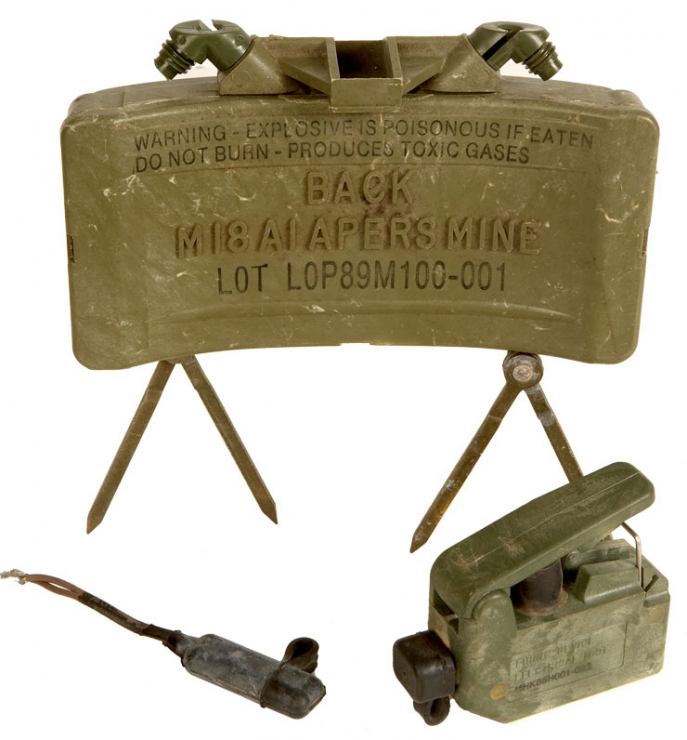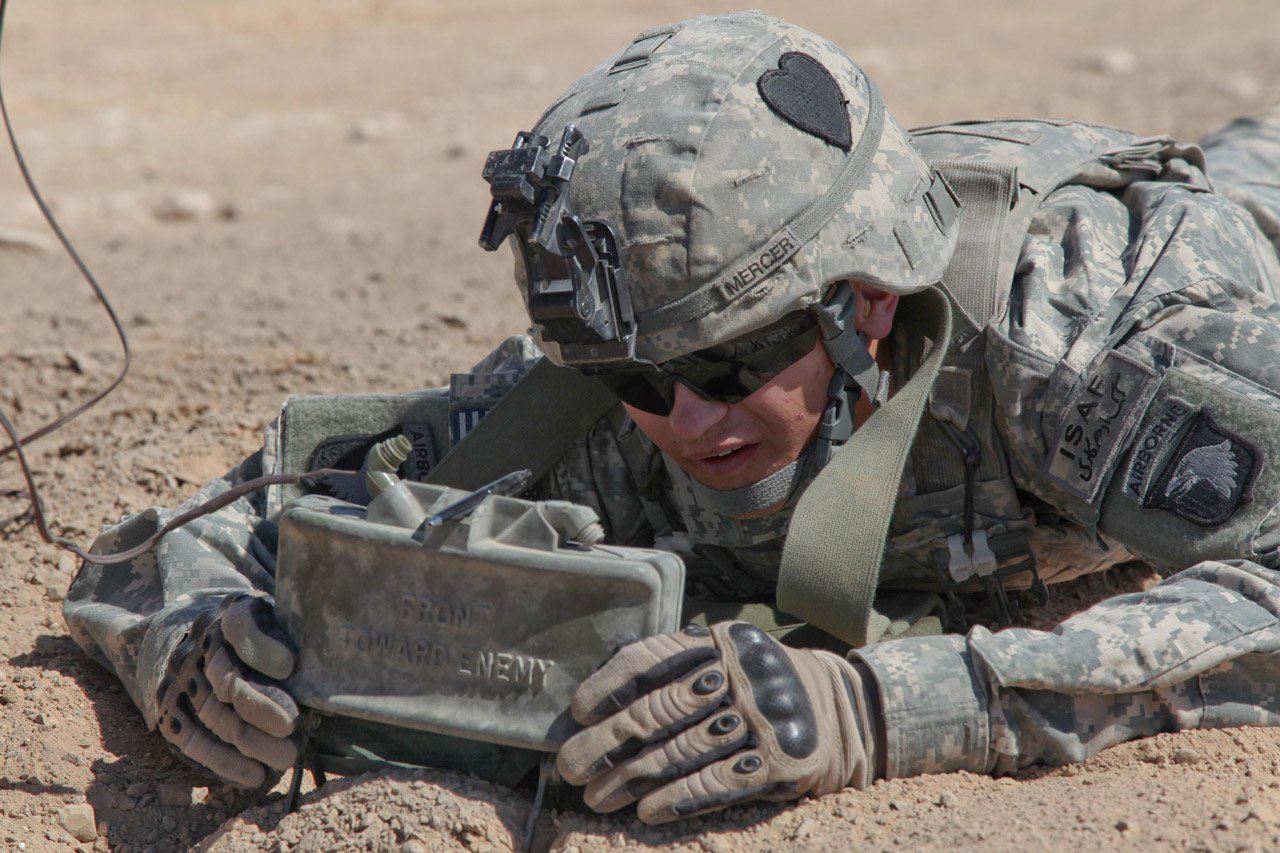
U.S. M18A1 Claymore AntiPersonnel Display Mine International Military Antiques
The Anti-Personnel Mine Ban Convention aims to do just that, "to end for all people and for all time the suffering caused by anti-personnel mines.". [ 4] The convention sets ambitious targets: states-parties may not use, develop, produce, stockpile, transfer, or acquire anti-personnel mines. [ 5] They have four years to destroy all.

Le M18A1 Claymore est une mine antipersonnel utilisé par l'armée américaine., Mleeta, Musée du
Arsenal | The Claymore: A compact killer. Naming his invention after the famous Scottish two-handed Claymore sword, Norman MacLeod applied the German-Hungarian anti-personnel mine research of World War II to a mine intended to counter Chinese human wave attacks during the Korean War. Introduced into service in 1954 as the M-18, Mac Leod's.

M18A1 Claymore Directional AntiPersonnel Mine Infographics
Washington —. Ukraine's government said Tuesday that a human rights report detailing "numerous cases" in which Ukrainian forces deployed banned anti-personnel mines "will be duly studied.

U.S. M18A1 Claymore AntiPersonnel Display Mine International Military Antiques
The M18A1 "Claymore" Anti-personnel Mine carries an explosive weight of 682-grams (1.50-lbs. of Composition C-4). It will deliver steel fragments over a 60° fan-shaped pattern that is 50-meters wide and 2-meters in height, and is effective up to a range of 100-meters.

M18 Claymore AntiPersonnel Mine Jordan Film Rental
The United States has transferred commanded-detonated M18A1 Claymore mines (without their victim-activated fuzes).. New Zealand condemns any and all use of anti-personnel mines," 30 March.

M18A1 CLAYMORE ANTIPERSONNEL MINE
The result was a more efficient and deadly directional anti-personnel mine with an effective range up to 100 meters. Within a range of 55 yards (50 meters,) the updated mine would hit about 30% of the enemy. With small changes, this new variant was standardized as the M18A1 Claymore anti-personnel mine.

Inert M18A1 Anti personnel Claymore Mine Militaria
In the uncontrolled role, the CLAYMORE is considered a mine or boobytrap (FM 20-32 ). Section II. DESCRIPTION 3. General The M18A1 antipersonnel mine was stand-ardized in 1960, and replaced the M18 anti-personnel mine (app. II). Both mines are sim-ilar in appearance and functioning.The M18A1 (fig. 1) is a directional, fixed-fragmen-tation mine.

M33 "Claymore" (& M18A1) antipersonnel mine (MUN 28)
The Claymore mine is a directional anti-personnel mine developed for the United States Armed Forces.Its inventor, Norman MacLeod, named the mine after a large medieval Scottish sword.Unlike a conventional land mine, the Claymore may be command-detonated (fired by remote-control), and is directional, shooting a wide pattern of metal balls into a kill zone.

M18A1 Claymore antipersonnel antipersonnel mine. A real US made M18 groundemplaced mine; a
An anti-personnel mine or anti-personnel landmine (APL) is a form of mine designed for use against humans, as opposed to an. and anti-tank mines. M18 Claymore: directional mine. M86 Pursuit Deterrent Munition: tripwire triggered bounding mine that automatically deploys its own tripwires. It is intended to be dropped by special forces when.

Matrix M18A1 Claymore Airsoft AntiPersonnel Mine w/ Trip Wire and Remote Clacker, Accessories
The M18 series, or Claymore mine ( Figure C-5), is a nonself-destructing directional fragmentation mine detonated by 682 grams of composition C4. The Claymore projects 700 steel balls in a fan-shaped pattern in a 60-degree arc to a maximum height of 2 meters. The M18 can be activated in the command-detonation mode by an electric blasting cap.

M18 Claymore AntiPersonnel Mine Minuteman Militia
The M18A1 Claymore is a directional anti-personnel mine used by the U.S. military. Its inventor, Norman MacLeod, named the mine after a large Scottish medieval sword. Unlike a conventional land.

The M18A1 Claymore is a directional antipersonnel mine used by the Stock Photo 62140336 Alamy
A large anti-personnel mine, the Claymore was developed principally by inventor Norman MacLeod in the 1950s. Unlike other anti-personnel mines that are buried in the ground and often activated by the pressure of a soldier's foot, the Claymore is attached to a stationary object above ground and fired by remote control. 10,000 Claymores Produced

M33 "Claymore" (& M18A1) antipersonnel mine Imperial War Museums
We're pleased to have an opportunity to speak to the changes that we've announced today to U.S. anti-personnel landmine policy. As a reminder, this call is on the record, but it is embargoed until the conclusion of the call.. The Claymore mines that were transferred by the U.S. Government to Ukraine are command-detonated with a person in.

Matrix M18A1 Claymore Airsoft AntiPersonnel Mine w/ Trip Wire and Remote Clacker Hero Outdoors
The M18 Claymore anti-personnel mine was developed into two distinct versions - one with a peep-type sight and the other without. The peep sight was devised to help give a Claymore operator a "field-of-vision" for the semi-circle blast pattern presented by the M18 when detonated. A training version is noted by its bold blue color whereas.

U.S. M18A1 Claymore AntiPersonnel Display Mine International Military Antiques
As Army Times writes, the service's inventory runs from the Vietnam War-era Claymore mine to the new Gator anti-tank/anti-personnel mines. The service wants to replace all of them with a new.

U.S. M18A1 Claymore AntiPersonnel Display Mine International Military Antiques
A claymore mine is a basic anti-personnel mine with massive stopping power. It's a plastic housing containing an explosive charge, approximately 700 steel ball bearings, and a detonation device.